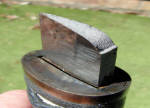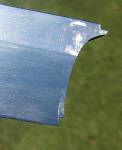© 2009 - SSJS, Sei Do Kan Dojo All rights reserved.
When I bought this katana some 9 years ago, who would have thought that, after having performed thousands of cuts on bamboo, bone, dowels and tatami-omote, it would one day fail in the most spectacular way imaginable.
This particular blade was made from a mono steel bar and evenly quenched/heat-treated to 59 Rockwell without a temper-line hamon and at the mune-machi had a thickness of 6mm. All in all a well balanced, sturdy and relaiable blade.
On Saturday 12 September 2009, while performing suemono-giri on just 4 stacked mats (1) , suddenly the word tameshigiri acquired a complete new meaning when, without warning, the blade let out a high pitched sound of extremely stressed metal snapping. The next thing I remembered was a sharp pain on the top of my right hand, a nasty whistling sound past the right side of my face and neck and - a split second later - a mighty thud of the blade hitting the floor (x) .
After a moment of stunned silence I realised that all I now held in my hands was the tsuka minus blade, tsuba, seppa and fuchi. Next I remember students rushing towards me and my first words were:"Do you see any blood?" After a long pause my seniors gave me the all clear when I noticed a bruise and a small 5mm cut on my right hand. It took some time to realise that the blade had actually broken off near the handle (2) , cleanly snapping through from the ha-machi to the mune-machi; bending and splitting the habaki (3) in the process.
a) There was evidence of grain growth
(4)
which could have weakened the blade.
This grain growths could have happened when, in 2000 and due to stress fractures along the cutting edge, the blade had to be re-worked, quenched and heat treated for a second time.
b) On the underside (cutting edge) of the blade near the ha-machi there is evidence of some rough grind marks
(5)
. If those grind marks had been done while the blade was already in a hardened condition it is possible that this would have created stress-concentrations and small cracks (brittle fractures). It is interesting to note that the blade actually cracked and broke along one of those grind marks! If this part of the blade would have been polished to a smooth surface, those minute brittle fracture may not have developed and no breakage would have occurred.
This blade failure shows that modern target-cutting can be as hazardous and dangerous as the actual testing of a blade.
o
o
o
o
(X)










